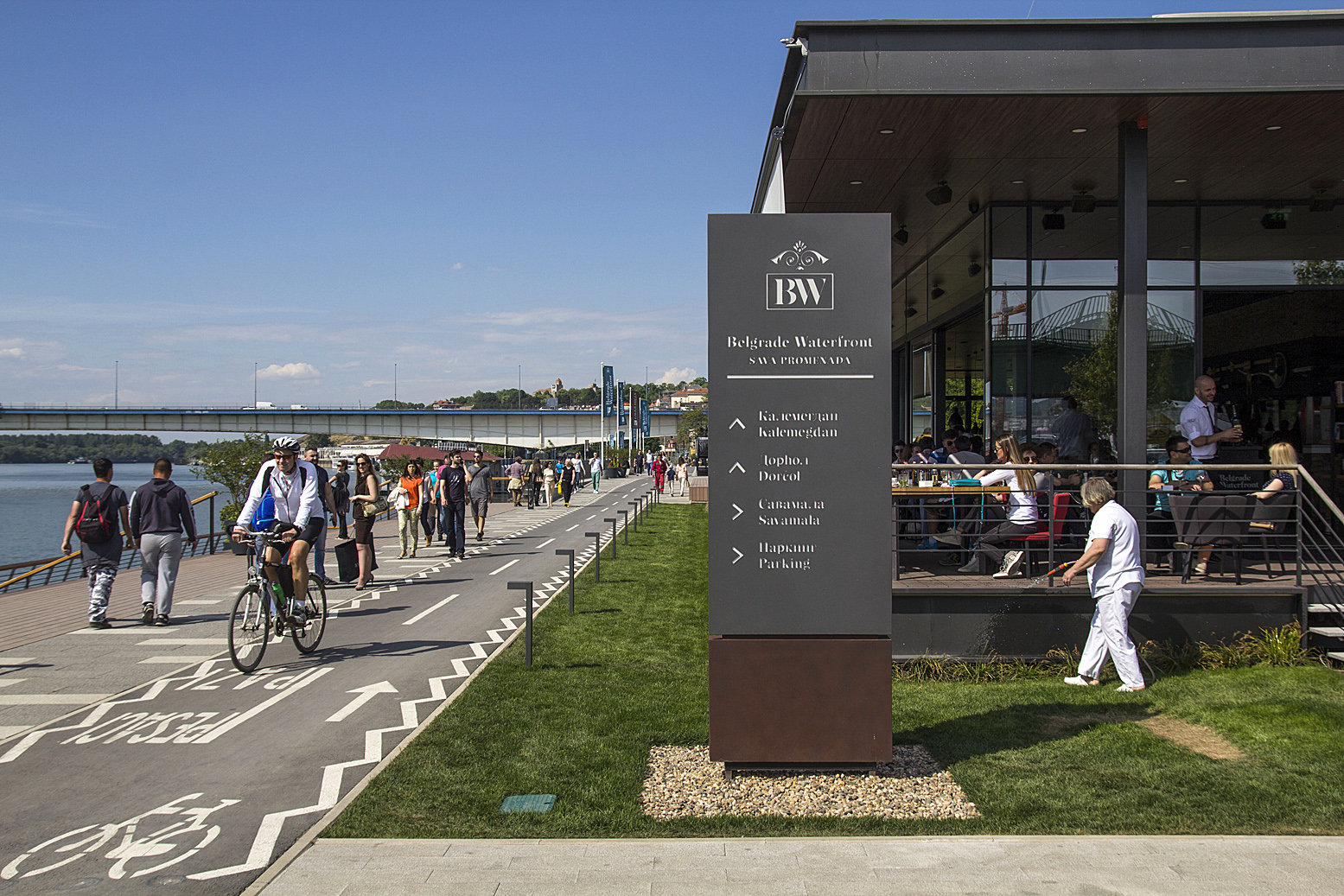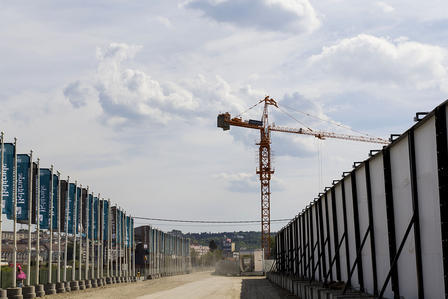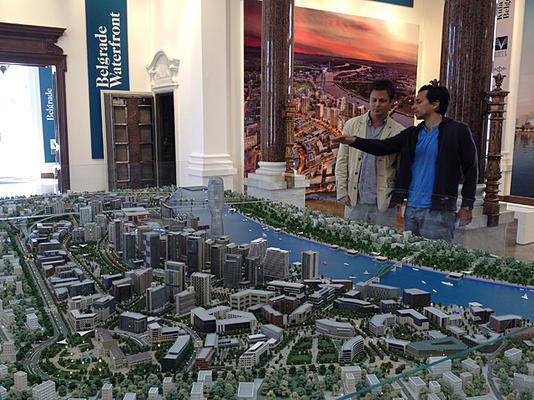
Savamala (Photo G. Vale)
The story of a district forgotten by the authorities, made alive by citizens, and finally seized by force to build the pharanoic project “Belgrade on water”
What happened to Danilo Antić ? Along the docks of the Sava, behind the Belgrade railway station, Dane – as they called him in the neighbourhood – has disappeared. No trace of his raspy heavy smoker laugh and of his street kiosk, always full of fresh beers and fishing worms. He's gone for good, they say, following the example of the fishermen who left Savamala after the arrival of the first bulldozers.
This slope of apartments, local markets, and small gardens, that climb from the river to the old town, has been declared a huge construction site. The government and the municipality gave the green light to a project for over 3 billion Euros, that will completely change the profile of this area, for a long time at the margins of Belgrade's development.
Peeling facades and precarious sidewalks will be replaced by a 160-metre skyscraper, a shopping mall, and a number of blazing residential buildings with large windows. A new skyline, which is not going to include the sale of fishing worms on the roadside.
Those who hang out on the riverfront argue that Dane has most probably moved across the Sava to Novi Beograd, where you can still throw a fishing line in the water in peace. Yet, finding him will not be easy. The pharaonic plan known as "Beograd na vodi" (Belgrade on water) is in fact shaking the daily life of the neighbourhood. To track this atypical Belgrade resident, formerly living in Germany, it will be necessary to review the history of Savamala and meet some of its protagonists.
Before Belgrade on water
Before the arrival of bulldozers and Arab investors, announced by the current Prime Minister, Aleksandar Vučić, this triangle nestled between Kalemegdan, the Republic Square, and the arrival point of the railway tracks, was an area forgotten by the authorities, but rediscovered by the capital's youth. Abandoned buildings – sometimes even without roof, like the "Spanish House" – attracted dozens of students, artists, and activists, eager to reactivate the dynamism of the area and its untapped potential.
In 2009, the European Centre for Culture and Debate, more commonly known as "KC Grad", was created, in an old warehouse in the industrial area by the river. In the same year, the "Mikser Festival" started, an annual event devoted to creativity and innovation (which now reached its eighth edition). A year later, the search of the Goethe Institut for new premises led to a series of cultural and artistic activities in the district, which in 2011 took the name of "Urban Incubator".
Savamala was crossed by new energy, marked every summer by the various “Mikser Festivals ” that slowly reanimated the neighbourhood, involving its residents. At the 2013 edition, an old resident showed up with a cart of fresh beers at 100 dinars..." I sold 107 in one night!", he would later recall, winking with satisfaction. In those years, before the project "Beograd na vodi" began, in 2015, a professor of architecture at the University of Belgrade had also invented a "school of urban practices", bringing his students to take an interest in the fate of Savamala.
Two different visions of the public space
"It's a bit like fixing the city piece by piece", says Professor Ivan Kucina, who now teaches at the University of Dessau, in Germany, the city cradle of the Bauhaus movement at the beginning of the twentieth century. Walking along the recently modernised Karađorđeva, Kucina reflects on the evolution of the district. "Four years ago there was nothing here, just trucks, noise, and pollution," says the architect. "Something needed to be done, but not like this". On the riverside, Kucina observes the construction site and cordoned off areas, shaking his head. The workers before him have been trying for days to drain the plot of land where the new skyscraper will rise. Groundwater flows unabated, and is poured into the Sava in an endless stream.
"Like all post-socialist cities, Belgrade has moved from a period when the urban planning was mainly concerned with the public interest, to a new phase when private investors dictate decisions to the municipality", says the professor, while his eyes continue following the works. "Building a tower there, for example, is not technically impossible, but it is crazy", argues the founder of the "school of urban practices". His pedagogical experiment, he said, intended to bring in students of architecture to the district, in order to "help frustrated citizens seek new ways to design and build its common areas". He did in fact start from the needs and desires of the inhabitants to rethink those places fallen into disuse – a participatory approach, diametrically opposed to the "top-down" approach of "Beograd na vodi".
One may smile at the idea that, in order to decide the development of the Serbian capital, the municipality of Belgrade should have listened to Dane, the peddler of the riverfront. Yet, what is ironic is rather the fact that the residents of Savamala – and Belgrade in general – have been completely excluded from a project that affects them closely. "It's an urban plan based on private interests rather than public needs", continues Professor Kucina, "as shows the fact that less than 1% of the area under consideration is devoted to public services, such as schools and clinics".
If urbanism becomes political
The model of the mega-project, developed by the Eagle Hills company from Abu Dhabi, is displayed in the recently renovated Geozavod, one of the most beautiful historic buildings in Belgrade. In a living room lit by large windows on three sides, two hostesses are available to visitors to provide all the information about the project, and ask them not to take pictures with professional equipment. The summary is repeated fast: 1.8 million square metres, 5,700 new housing units, 2,200 hotel rooms, and offices for 12,700 people. All around is the slogan: "Live your life as a celebration".
The images presented at the Geozavod come alive on the walk along the Sava, remodelled in 2015 with part of the budget allocated to the "Beograd na vodi" marketing. Green grass carpets curbside, handrails and wooden benches on the riverside, modern street lighting in black metal. "It's definitely more beautiful than before, but this is not the point", says Ivan Kucina, continuing past the new cocktail bar overlooking the water. "The point is that this no longer looks like a public space – in fact, we are facing disguised privatisation. The riverside is becoming a theme park". And the theme park, reminiscent of glossy airline magazines, clashes with reality. "Rents in Belgrade have been falling for 10 years. Does it really make sense to put on the market thousands of apartments at 3,500 Euros per square metre?", asks the architect.
The lack of involvement of the inhabitants, the opacity of funding, and the legal shortcuts taken by the government to advance the work (a "lex specialis" was approved by parliament to handle faster expropriations) earned the project a lively opposition. The movement "Ne da(vi)mo Beograd" (a play of words on not selling out/drowning Belgrade) has brought its giant yellow duck – the symbol of the protest – around the capital, while the opposition to the urban plan has brought together different groups of otherwise quarrelsome artists and activists.
"Although Vučić will make it with this project, I'm sure it will be his last act. In fact, it created a united front and made people more involved and more interested in public affairs", says Ana Đorđević-Petrović, among the makers of the video "Our Belgrade on water ", also available in English, which has become viral in a few days. At the Goethe Institut, director Matthias Müller-Wieferig is more cautious, but reminds that "citizen participation is no longer an optional 'good thing', but a necessity if we are to avoid protests, political damage, and costly delays”.
''Beograd na vodi reminds me of the German urban project Stuttgart 21, that wanted to build a new rail hub in Stuttgart, with improvements in transportation and the construction of a new district by investor initiative", says Müller Wieferig, "ignoring civil society and its criticism; the political class has faced several years of mass protests and delays in the works – and finally, also political defeat, when in the following election the Greens beat the Conservative Party in Baden-Württemberg and made a referendum on the project”.
Can Savamala really put an end to the Vučić era? In fact, although opposition to the mega-site grows and organises (nearly 5,000 people took to the streets on May 11th to demand the resignation of Mayor Siniša Mali), the project goes ahead anyway, sometimes in the most surprising illegality. In late April, about thirty people with sticks and ski masks raided the neighbourhood at night , destroying with two bulldozers fifteen shacks between Mostar and Herzegovina streets. The houses in question had been built over the years without permits, but this type of demolition is obviously just as illegal.
Serbian legislation, argues the Belgrade daily Politika , prescribes the presence of a municipal inspector – according to practice, also of a police officer, not to mention the fact that demolitions are to be carried out only during the day and an eviction notice must be delivered to the property owner in good time. In Savamala, needless to say, this framework is collapsing along with the houses. And the Ombudsman's appeals to open an investigation into these mysterious demolitions did not produce results so far.
Where did Dane go?
After the events of the end of April, to find the latest shacks still standing along the Sava you have to walk against the current, until the Gazela bridge, the most important road axis linking the capital with its suburb of Novi Beograd, across the river. It is here, with greasy hands and a cigarette in the corner of his mouth, that Danilo Antić is repairing his motorcycle, waiting for the eviction. "There are two houses: mine, and another one. Mine will be the last to be demolished", says Dane, sitting on a concrete wall. "I could have moved two months ago, but I did not want to. I was offered a flat in Autokomanda [a district of Belgrade, ed.], but I want to stay by the river".
Between a snort of smoke and laughter ending in worrying coughs, Dane tells of his thirteen years spent bargaining along the Sava. The idea came to him one day when, as a fisherman, he found himself with no bait and no one wanted to sell him some. "So I went in search of worms and, in a corner of the river, I realised that there were many, to the point that the fish approached the shore to eat them!", remembers Dane, amused. Since then it has been a growing business: in addition to worms, he would sell Turkish coffee and beers, while his bike turned into a small motorised cart and made Danilo Antić a star of Savamala.
"Hey neighbour!", greets a cyclist, pressing on the brakes.
"You still here?", answers Dane.
"They throw me out tomorrow".
"And where will you go?"
"They gave me some money, I bought two apartments in Jajinci [another Belgrade district, 10 kilometres from the centre, ed.]".
"Are you satisfied?", asks Dane, wonderingly.
"No! The apartment is only free from August, where will I go in the meantime?"
"Will you come back to drink a lemonade or a cup of coffee with me near the river?"
"Definitely!"
"Call me!"
"See you soon!"
"I know everyone here”, apologises Dane, “not a day goes by without seeing a familiar face".
He too was offered an alternative by the municipality, in exchange for his land in Savamala. He will live in Žarkovo, a suburb to the south, not far from the river.
"I have found a ground floor apartment with a small garden. I asked if I could park my motorcycle there, and they said yes", says Dane. Now that fishermen have abandoned the old docks invaded by bulldozers, Dane has readjusted his business to sell soft drinks and coffee in the stands of the Novi Beograd market. But the worms are still safe, "in secret places along the Sava, in Pančevo, or the Great War Island". When the fishing season begins, although now out of the centre of Belgrade, Dane dusts off his motorcycle and goes back to making the fishermen rounds.
Who owns the city?
"As for public spaces, you must not only think about cemented, but rather about giving space and voice to the community of citizens". Interviewed by "La lettura", a magazine of the Italian newspaper Corriere della Sera, architect Alejandro Aravena (also curator of the Venice Biennale opened on May 28th) illustrates the relationship between urban planning and population. "If we do not change course, the city of the future will no longer be a metropolis, but slums and existential prisons", warns Aravena, who won this year's Pritzker Prize.
What do these words mean in the context of Savamala? What direction should Belgrade take about its riverfront?
The most relevant and informed answer would certainly be given by the residents themselves. What if the municipality applied the methodology used by the School of urban practices (SUP) in the Savamala district? Rather than accept a ready-made project imagined in Abu Dhabi, 5,000 kilometres away, it would proceed to an inquiry on the needs, desires, and complaints of the people, and then build a map and a shared model. "It's not about making everyone happy. But reaching an agreement on a joint text makes everyone participate. From our side, therefore, what we find most interesting is the process, rather than the construction of the space that follows", explains architect Olivera Petrović, an activist of the SUP.
Of course, this is not about transforming Belgrade into a chaotic assembly of nearly two million people, but crossing ideas from all quarters. On Savamala, for example, Danilo Antić would have suggested that "a cleaning is required, since there are broken bottles, boats, and scraps everywhere". Professor Kucina would half-jokingly suggest "a beach" along the river, as in Novi Sad. Others would have highlighted their favourite places in the neighbourhood, like the historic Lokum shop opened since 1936, and the démodé bar-hotel where the clocks have stopped God knows how long ago. Taking into account the dreams of its citizens, the municipality would not only have presented a better project, but also fulfilled its mission, namely that of acting in the public interest.
It is no coincidence that, in all languages, the words "city" and "citizens" share the same root. Yet, all too often, the administrators of the former think they can do without the advice of the latter.








